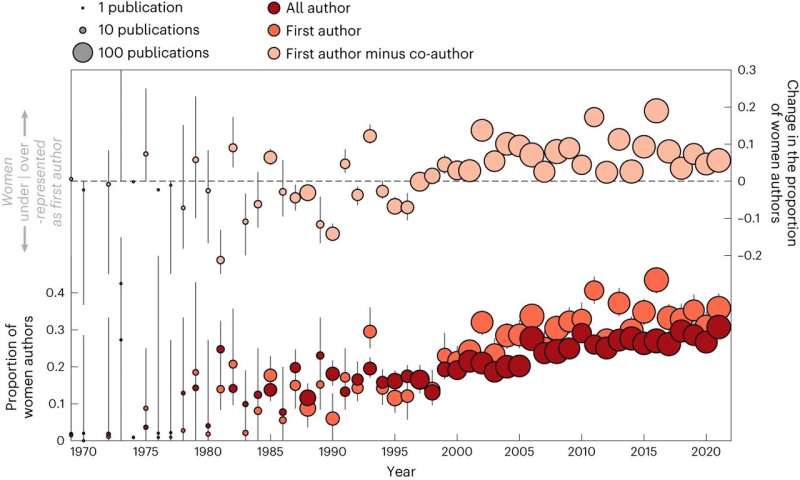 Trends in women authorship in ice core science. The changing proportions of women first authors versus all authors (bottom) through time. The difference between first and co-author proportions (providing an ‘out-of-sample’ comparison) is shown above; positive (negative) values indicate that women are over- (under)represented as first authors. Beginning in the late 1990s, the proportion of woman first-authored studies exceeds the total woman co-author proportion. Bubble sizes indicate the number of publications per year, and vertical lines indicate the gender proportion 95% confidence interval based on Monte Carlo resampling of genderize.io-derived probabilities (Methods). Credit: Nature Geoscience (2023). DOI: 10.1038/s41561-023-01315-y
Trends in women authorship in ice core science. The changing proportions of women first authors versus all authors (bottom) through time. The difference between first and co-author proportions (providing an ‘out-of-sample’ comparison) is shown above; positive (negative) values indicate that women are over- (under)represented as first authors. Beginning in the late 1990s, the proportion of woman first-authored studies exceeds the total woman co-author proportion. Bubble sizes indicate the number of publications per year, and vertical lines indicate the gender proportion 95% confidence interval based on Monte Carlo resampling of genderize.io-derived probabilities (Methods). Credit: Nature Geoscience (2023). DOI: 10.1038/s41561-023-01315-y
A Perspective article published today in Nature Geoscience tackles the longstanding issue of gender representation in science, focusing on the field of ice core science.
Prior work has shown that despite progress toward gender parity over the past fifty years, women continue to be significantly underrepresented within the discipline of Earth sciences and receive disproportionately fewer opportunities for recognition, such as invited talks, awards, and nominations. This lack of opportunity can have long-term negative impacts on women's careers.
To help address these persistent gender gaps, the study evaluates patterns related to women's publication in ice core science over the past fifty years. The study was co-led by Bess Koffman of Colby College, USA, and Matthew Osman of Cambridge University, UK, and co-authored by Alison Criscitiello and Sofia Guest, both of the University of Alberta, Canada.
To assess relationships among gender, publication rate, and impact of coauthor networks, the study evaluates a comprehensive, global dataset of abstracts representing published work in ice core science spanning 1969 to 2021 in this historically male-dominated discipline. The article shows that the inferred gender gap in ice core science has declined from roughly 10:90% women:men in the 1970s to ~30:70% in the past decade. Contrasting with prior work across the sciences, the authors find that women's and men's co-author networks have remained similarly sized and been similarly cited through time. This finding may reflect the high degree of international cooperation and the large collaborative teams that are typical of the field of ice core science.
Importantly, the gender makeup of co-authors differs substantially for man vs. woman-led studies. Strikingly, within the past decade, woman-led studies have contained on average 20% more women coauthors than man-led studies, a difference found to be even greater in earlier decades.
Moreover, since the early 2000s, the analysis shows that women have outperformed by about 8% their estimated proportion within the ice core community in terms of publishing first-authored papers. The new analysis by Koffman, Osman, Criscitiello and Guest suggests that senior women in particular catalyze women's participation in publishing, and that collaboration between women can help close gender gaps in science.
More information: Bess G. Koffman et al, Collaboration between women helps close the gender gap in ice core science, Nature Geoscience (2023). DOI: 10.1038/s41561-023-01315-y
Citation: Collaboration between women helps close the gender gap in ice core science (2023, November 27) retrieved 27 November 2023 from https://phys.org/news/2023-11-collaboration-women-gender-gap-ice.html
This document is subject to copyright. Apart from any fair dealing for the purpose of private study or research, no part may be reproduced without the written permission. The content is provided for information purposes only.


















 English (United States) ·
English (United States) ·